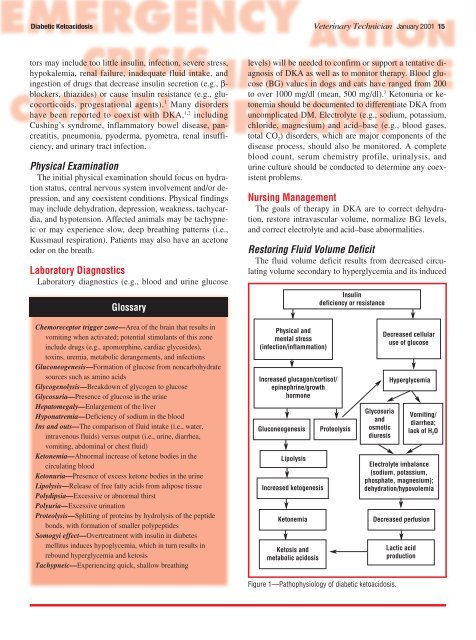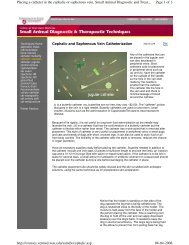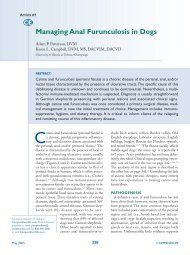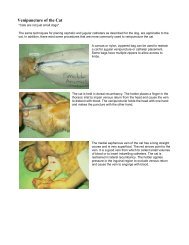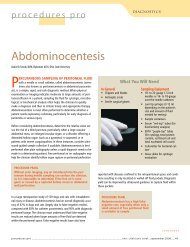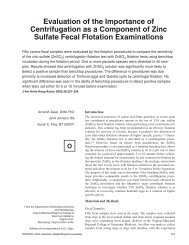Diabetic Ketoacidosis - Hungarovet
Diabetic Ketoacidosis - Hungarovet
Diabetic Ketoacidosis - Hungarovet
You also want an ePaper? Increase the reach of your titles
YUMPU automatically turns print PDFs into web optimized ePapers that Google loves.
<strong>Diabetic</strong> <strong>Ketoacidosis</strong> Veterinary Technician January 2001 15<br />
tors may include too little insulin, infection, severe stress,<br />
hypokalemia, renal failure, inadequate fluid intake, and<br />
ingestion of drugs that decrease insulin secretion (e.g., β-<br />
blockers, thiazides) or cause insulin resistance (e.g., glucocorticoids,<br />
progestational agents). 1 Many disorders<br />
have been reported to coexist with DKA, 1,2 including<br />
Cushing’s syndrome, inflammatory bowel disease, pancreatitis,<br />
pneumonia, pyoderma, pyometra, renal insufficiency,<br />
and urinary tract infection.<br />
Physical Examination<br />
The initial physical examination should focus on hydration<br />
status, central nervous system involvement and/or depression,<br />
and any coexistent conditions. Physical findings<br />
may include dehydration, depression, weakness, tachycardia,<br />
and hypotension. Affected animals may be tachypneic<br />
or may experience slow, deep breathing patterns (i.e.,<br />
Kussmaul respiration). Patients may also have an acetone<br />
odor on the breath.<br />
Laboratory Diagnostics<br />
Laboratory diagnostics (e.g., blood and urine glucose<br />
Glossary<br />
levels) will be needed to confirm or support a tentative diagnosis<br />
of DKA as well as to monitor therapy. Blood glucose<br />
(BG) values in dogs and cats have ranged from 200<br />
to over 1000 mg/dl (mean, 500 mg/dl). 3 Ketonuria or ketonemia<br />
should be documented to differentiate DKA from<br />
uncomplicated DM. Electrolyte (e.g., sodium, potassium,<br />
chloride, magnesium) and acid–base (e.g., blood gases,<br />
total CO 2 ) disorders, which are major components of the<br />
disease process, should also be monitored. A complete<br />
blood count, serum chemistry profile, urinalysis, and<br />
urine culture should be conducted to determine any coexistent<br />
problems.<br />
Nursing Management<br />
The goals of therapy in DKA are to correct dehydration,<br />
restore intravascular volume, normalize BG levels,<br />
and correct electrolyte and acid–base abnormalities.<br />
Restoring Fluid Volume Deficit<br />
The fluid volume deficit results from decreased circulating<br />
volume secondary to hyperglycemia and its induced<br />
Insulin<br />
deficiency or resistance<br />
Chemoreceptor trigger zone—Area of the brain that results in<br />
vomiting when activated; potential stimulants of this zone<br />
include drugs (e.g., apomorphine, cardiac glycosides),<br />
toxins, uremia, metabolic derangements, and infections<br />
Gluconeogenesis—Formation of glucose from noncarbohydrate<br />
sources such as amino acids<br />
Glycogenolysis—Breakdown of glycogen to glucose<br />
Glycosuria—Presence of glucose in the urine<br />
Hepatomegaly—Enlargement of the liver<br />
Hyponatremia—Deficiency of sodium in the blood<br />
Ins and outs—The comparison of fluid intake (i.e., water,<br />
intravenous fluids) versus output (i.e., urine, diarrhea,<br />
vomiting, abdominal or chest fluid)<br />
Ketonemia—Abnormal increase of ketone bodies in the<br />
circulating blood<br />
Ketonuria—Presence of excess ketone bodies in the urine<br />
Lipolysis—Release of free fatty acids from adipose tissue<br />
Polydipsia—Excessive or abnormal thirst<br />
Polyuria—Excessive urination<br />
Proteolysis—Splitting of proteins by hydrolysis of the peptide<br />
bonds, with formation of smaller polypeptides<br />
Somogyi effect—Overtreatment with insulin in diabetes<br />
mellitus induces hypoglycemia, which in turn results in<br />
rebound hyperglycemia and ketosis<br />
Tachypneic—Experiencing quick, shallow breathing<br />
Physical and<br />
mental stress<br />
(infection/inflammation)<br />
Increased glucagon/cortisol/<br />
epinephrine/growth<br />
hormone<br />
Gluconeogenesis<br />
Lipolysis<br />
Increased ketogenesis<br />
Ketonemia<br />
Ketosis and<br />
metabolic acidosis<br />
Proteolysis<br />
Glycosuria<br />
and<br />
osmotic<br />
diuresis<br />
Decreased cellular<br />
use of glucose<br />
Hyperglycemia<br />
Vomiting/<br />
diarrhea;<br />
lack of H 2 O<br />
Electrolyte imbalance<br />
(sodium, potassium,<br />
phosphate, magnesium);<br />
dehydration/hypovolemia<br />
Decreased perfusion<br />
Lactic acid<br />
production<br />
Figure 1—Pathophysiology of diabetic ketoacidosis.


